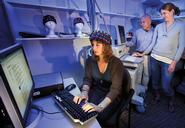
Several members of the Hamilton community were co-authors of a paper published in the journal Advances in Human-Computer Interaction.
“Using Noninvasive Brain Measurement to Explore the Psychological Effects of Computer Malfunctions on Users during Human-Computer Interactions” presented the results of research done by Leanne Hirshfield ’02 and Stuart Hirshfield, the Stephen Harper Kirner Professor of Computer Science, along with Mathew Farrington ’12, Spencer Gulbronson ’12 and Diane Paverman ’13. Researchers from Gettysburg College and Illinois State University also participated.
They used two non-invasive brain measurement techniques – functional near-infrared spectroscopy (fNIRS) and galvanic skin response sensors – to measure users’ cognitive and emotional responses to computer problems, in particular a slow-down of Internet speed and the introduction of malware onto the computer system that caused it to crash. Those results were compared to users’ surveys of their perceived emotional state, cognitive load and trust level.
According to the article’s abstract, the “cognitive and emotional changes were correlated with users’ self-report levels of suspicion and trust, and they in turn suggest future work that further explores the capability of fNIRS for the measurement of user experience during human-computer interactions.”
Posted January 28, 2015
